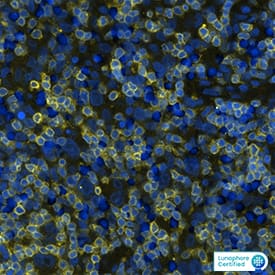Human CD3 epsilon Antibody Summary
Gln22-Asp126
Accession # P07766
*Small pack size (-SP) is supplied either lyophilized or as a 0.2 µm filtered solution in PBS.
Applications
Please Note: Optimal dilutions should be determined by each laboratory for each application. General Protocols are available in the Technical Information section on our website.
Scientific Data
 View Larger
View Larger
Detection of CD3ɛ in Human T-Cell Lymphoma via seqIF™ Staining on COMET™ CD3ɛ was detected in immersion fixed paraffin-embedded sections of human T-Cell Lymphoma using Mouse Anti-Human CD3ɛ Monoclonal Antibody (Catalog # MAB10670) at 18ug/mL at 37 ° Celsius for 2 minutes. Before incubation with the primary antibody, tissue underwent an all-in-one dewaxing and antigen retrieval preprocessing using PreTreatment Module (PT Module) and Dewax and HIER Buffer H (pH 9; Epredia Catalog # TA-999-DHBH). Tissue was stained using the Alexa Fluor™ 647 Goat anti-Mouse IgG Secondary Antibody at 1:200 at 37 ° Celsius for 2 minutes. (Yellow; Lunaphore Catalog # DR647MS) and counterstained with DAPI (blue; Lunaphore Catalog # DR100). Specific staining was localized to the membrane of T-cells. Protocol available in COMET™ Panel Builder.
 View Larger
View Larger
Detection of Human CD3 epsilon by Western Blot. Western blot shows lysates of MOLT‑4 human acute lymphoblastic leukemia cell line and Jurkat human acute T cell leukemia cell line. PVDF membrane was probed with 2 µg/mL of Mouse Anti-Human CD3 epsilon Monoclonal Antibody (Catalog # MAB10670) followed by HRP-conjugated Anti-Mouse IgG Secondary Antibody (HAF018). A specific band was detected for CD3 epsilon at approximately 23 kDa (as indicated). This experiment was conducted under reducing conditions and using Western Blot Buffer Group 1.
 View Larger
View Larger
CD3 epsilon in Human Thymus. CD3 epsilon was detected in immersion fixed paraffin-embedded sections of human thymus using Mouse Anti-Human CD3 epsilon Monoclonal Antibody (Catalog # MAB10670) at 5 µg/mL for 1 hour at room temperature followed by incubation with the Anti-Mouse IgG VisUCyte™ HRP Polymer Antibody (VC001). Before incubation with the primary antibody, tissue was subjected to heat-induced epitope retrieval using Antigen Retrieval Reagent-Basic (CTS013). Tissue was stained using DAB (brown) and counterstained with hematoxylin (blue). Specific staining was localized to cell surface in lymphocytes. Staining was performed using our protocol for IHC Staining with VisUCyte HRP Polymer Detection Reagents.
 View Larger
View Larger
Detection of Human CD3 epsilon by Simple WesternTM. Simple Western lane view shows lysates of Jurkat human acute T cell leukemia cell line and MOLT‑4 human acute lymphoblastic leukemia cell line, loaded at 0.2 mg/mL. A specific band was detected for CD3 epsilon at approximately 30 kDa (as indicated) using 25 µg/mL of Mouse Anti-Human CD3 epsilon Monoclonal Antibody (Catalog # MAB10670). This experiment was conducted under reducing conditions and using the 2-40 kDa separation system.
Reconstitution Calculator
Preparation and Storage
- 12 months from date of receipt, -20 to -70 °C as supplied.
- 1 month, 2 to 8 °C under sterile conditions after reconstitution.
- 6 months, -20 to -70 °C under sterile conditions after reconstitution.
Background: CD3 epsilon
CD3 epsilon (T-Cell Surface Glycoprotein CD3 Epsilon) is a type I transmembrane protein that belongs to the Ig (Immunoglobulin) superfamily. Human CD3 epsilon consists of 104 amino acid (aa) extracellular domain, 26 aa transmembrane domain and 55 aa cytoplasmic domain (1). With the extracellular domain, human CD3 epsilon shares 44.2% and 49% homology with mouse and rat CD3 epsilon respectively. There are four CD3 proteins: CD3δ, CD3 epsilon, CD3 gamma, and CD3 zeta. All CD3 proteins contain ITAM (Immunoreceptor Tyrosine-based Activation Motifs) in the cytoplasmic tail, which becomes phosphorylated by Src family protein tyrosine kinases LCK and FYN upon TCR engagement (2). CD3 proteins form heterodimers of CD3δ/CD3 epsilon and CD3 gamma /CD3 epsilon, which bind to TCR and form trimeric TCR alpha /CD3 epsilon /CD3 gamma and TCR beta /CD3 gamma /CD3 epsilon. The resulting heterohexamer further associates with CD3 zeta homodimer and forms TCR/CD3 signaling complex (3, 4). Similar complex is also formed with TCR gamma and TCRδ (5). CD3 epsilon plays essential role in adaptive immune response. Mutations in CD3 epsilon lead to SCID (severe combined immunodeficiency) (6).
- Gold, D.P. et al. (1986) Nature 321:431.
- Barber, E.K. et al. (1989) Proc. Nat. Acad. Sci. U.S.A. 86:3277.
- Manolios, N. et al. (1991) EMBO J 10:1643.
- Dietrich, J. et al. (1999) Eur J Immunol 29:1719.
- Pan, Q. et al. (2006) Mol Immunol 43:1741.
- Soudais, C. et al. (1993) Nat. Genet. 3:77.
Product Datasheets
FAQs
No product specific FAQs exist for this product, however you may
View all Antibody FAQsReviews for Human CD3 epsilon Antibody
There are currently no reviews for this product. Be the first to review Human CD3 epsilon Antibody and earn rewards!
Have you used Human CD3 epsilon Antibody?
Submit a review and receive an Amazon gift card.
$25/€18/£15/$25CAN/¥75 Yuan/¥2500 Yen for a review with an image
$10/€7/£6/$10 CAD/¥70 Yuan/¥1110 Yen for a review without an image





